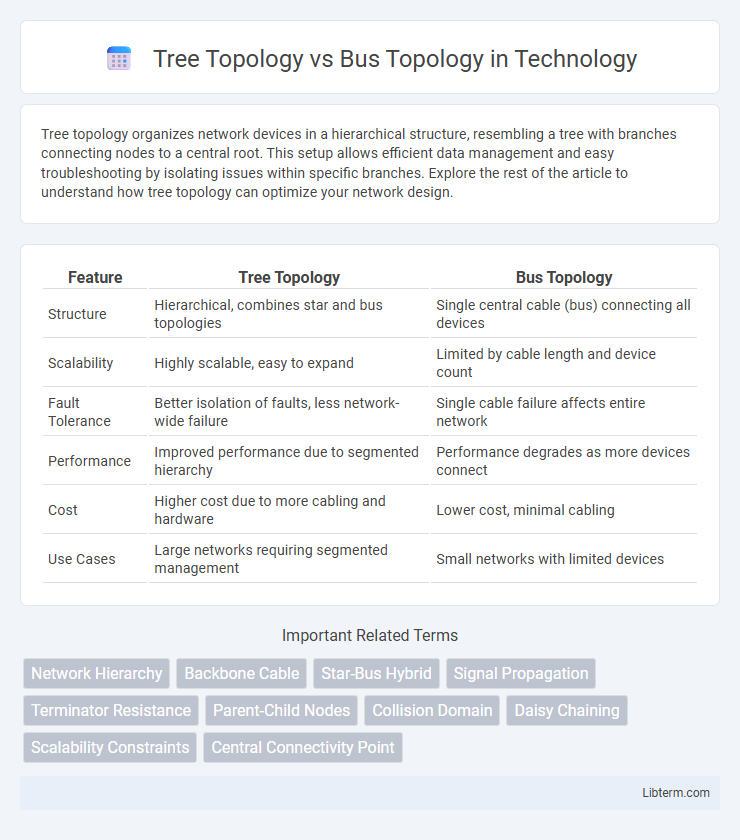Tree topology organizes network devices in a hierarchical structure, resembling a tree with branches connecting nodes to a central root. This setup allows efficient data management and easy troubleshooting by isolating issues within specific branches. Explore the rest of the article to understand how tree topology can optimize your network design.
Table of Comparison
| Feature | Tree Topology | Bus Topology |
|---|---|---|
| Structure | Hierarchical, combines star and bus topologies | Single central cable (bus) connecting all devices |
| Scalability | Highly scalable, easy to expand | Limited by cable length and device count |
| Fault Tolerance | Better isolation of faults, less network-wide failure | Single cable failure affects entire network |
| Performance | Improved performance due to segmented hierarchy | Performance degrades as more devices connect |
| Cost | Higher cost due to more cabling and hardware | Lower cost, minimal cabling |
| Use Cases | Large networks requiring segmented management | Small networks with limited devices |
Introduction to Network Topologies
Tree topology bridges multiple star topologies onto a bus, creating a hierarchical structure ideal for large networks requiring scalable and organized communication. Bus topology employs a single central cable, or backbone, to which all network devices connect, facilitating simple implementation but limited scalability and trouble isolation. Both topologies serve distinct roles: tree topology optimizes manageability and expansion, while bus topology suits smaller, less complex networks.
Overview of Tree Topology
Tree topology combines characteristics of star and bus topologies, structuring nodes in a hierarchical manner with a central root node branching out to multiple levels of sub-nodes. Each branch can act as a separate bus network, enhancing scalability and fault isolation compared to traditional bus topology. This hierarchical layout supports efficient data management and network expansion, commonly used in large organizational networks.
Overview of Bus Topology
Bus topology uses a single central cable, called the bus or backbone, to connect all devices in a network, facilitating data transmission via a shared medium. Each device taps into the bus directly, and signals travel in both directions until they reach the intended recipient, which makes it simple and cost-effective for small networks. However, bus topology faces performance issues and difficulties in troubleshooting as the number of devices increases, with network failure occurring if the central cable is damaged.
Structure Comparison: Tree vs Bus Topology
Tree topology features a hierarchical structure with multiple levels of nodes connected in a parent-child relationship, enabling scalable and organized network segmentation. Bus topology consists of a single central backbone cable to which all nodes are directly connected, facilitating simpler installation but limited scalability. The tree topology's layered branches provide better fault isolation and expandability compared to the linear bus topology which is more vulnerable to failures at the central cable.
Installation and Configuration Differences
Tree topology requires hierarchical installation with multiple levels of nodes connected in a parent-child structure, making configuration more complex due to the need to manage intermediate devices like switches or hubs. Bus topology involves a single central cable (the bus) connecting all devices directly, simplifying installation but requiring terminators at both ends to prevent signal reflection. Configuring a tree topology demands careful planning of branches and device roles, whereas bus topology configuration is straightforward but can be prone to network failures if the main cable is damaged.
Scalability in Tree and Bus Topologies
Tree topology offers superior scalability compared to bus topology due to its hierarchical structure that allows easy addition of nodes without disrupting the entire network. In contrast, bus topology faces limitations in scalability as increasing devices on the single communication line leads to signal degradation and collisions. The structured levels in tree topology facilitate organized expansion, making it ideal for large and complex networks.
Performance and Data Transfer Efficiency
Tree topology offers superior performance and data transfer efficiency compared to bus topology due to its hierarchical structure, which reduces data collisions and network congestion. In tree topology, multiple nodes can communicate simultaneously through dedicated branches, enhancing bandwidth utilization and minimizing latency. Bus topology suffers from limited performance as all devices share a single communication line, causing frequent data collisions and retransmissions that degrade overall transfer speed.
Fault Tolerance and Troubleshooting
Tree topology offers higher fault tolerance compared to bus topology by segmenting the network into hierarchical levels, allowing isolated failures without disrupting the entire system. Troubleshooting in tree topology is more efficient due to its structured layout, enabling pinpointing faults at specific branches or nodes. In contrast, bus topology is vulnerable to a single point of failure in the main cable, making fault detection and isolation more challenging and potentially causing network-wide outages.
Cost Implications and Resource Utilization
Tree topology incurs higher initial costs due to the extensive cabling and hardware required for hierarchical connections, whereas bus topology presents lower upfront expenses with minimal cabling needs. Resource utilization in tree topology allows better scalability and fault isolation, optimizing network performance but increasing maintenance complexity. Bus topology, while cost-effective for small networks, suffers from bandwidth limitations and potential signal collisions, leading to inefficient resource use as the network grows.
Choosing the Right Topology for Your Network
Tree topology offers hierarchical structuring with scalable branches, ideal for expanding networks requiring efficient management and fault isolation, while bus topology features a simple linear layout suited for small, temporary setups with minimal cable requirements. Selecting the right network topology depends on factors such as network size, scalability needs, fault tolerance, and ease of maintenance. Tree topology supports better performance in complex environments, whereas bus topology is cost-effective for limited devices and straightforward data traffic.
Tree Topology Infographic

 libterm.com
libterm.com